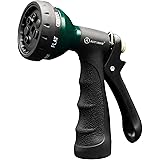Running a soaker hose for your tomato garden is an excellent way of watering your plants. It’s effective, less costly, and consumes significantly less water than any other plant watering technique. Even so, you have to know how to implement this method correctly to achieve the best results.
So, how long to run soaker hose for tomatoes?
Run a soaker hose for tomatoes for 30 minutes, two times a week for a trial session. After that, check how deep the water penetrates the soil and adjust accordingly. Also, assess the hydration level of your plants by their look. If your beds are on a raised ground, increase the water pressure to push it upwards.
This article provides sufficient information to help you use this mechanism the right way to attain the best results.
Also Check: Can You Plant Two Tomato Plants Together In A pot?
How Long To Run Soaker Hose For Tomatoes?
How long to run a soaker hose for your tomatoes depends on the bed or garden size, hose diameter, PSI, and the setup. Hence, you should water your plants until the soil is moist but not flooded.
Ensure your soil is damp about 6-8 inches below the ground to enhance the proper growth of the roots.
What Happens If You Fail To Allow Enough Time For The Soaker Hose To Water Your Tomatoes?
If you fail to allow enough time for your soaker hose to water your tomatoes, they develop serious problems including the following:
- Decreased resistance to diseases like root loss, blossom end rot, and others
- Stunted growth
- Low fruit production
- Poor quality fruit
- Vulnerability to pests
- Cracking
- Yellowing and dropping leaves
A significant part of the tomato fruit is made of water. Hence, you need to sufficiently water this plant to have a good, high-quality harvest. After all, that’s the aim of every gardener!
But then, is there any danger in leaving your soaker hose for prolonged hours? The answer lies in our next section.
What Are The Indicators Of Overwatered Tomato Plants?
There are three major indicators of overwatered tomato plants. Although the plants look similar to the underwatered ones, they have the following signs:
- The wilting and yellowing of leaves and stems
- Developing blisters and bumps on the leaves
- Falling off of the leaves
The other indicator of an excessively-watered tomato plant is the darkening of the roots, which also look slim. Healthy roots are pale yellow in color. Leaves darkening occurs in extreme cases.
How Does A Soaker Hose System Work?
A soaker hose system works by allowing water to “seep out” through its tiny holes along its length. This water “soaks” into the ground at the place where it’s most needed (around your plants’ base). The tiny holes resemble your skin’s pores and allow water out of the hose evenly and slowly.
All you need is to place your soaker hose near your plants’ base, turn on the water, and allow it to saturate the ground. Very little pressure is required and the hose’s porous materials maintain the low water pressure throughout the period.
Once the process kicks off, it only needs little supervision and the soaker hose will get the job done effectively.
How Do You Use A Soaker Hose To Water Tomatoes?
Below are the four key steps to take when you want to use a soaker to water your tomatoes.
- Soaker hose positioning
- Water connection
- Performance assessment and setting
- Hose mulching
Find an explanation of each of these steps below.
1. Soaker Hose Positioning
Place your soaker hose in your tomato bed or garden and allow it to rest adjacent to the plants’ base. The arrangement of your hose is dependent on the width as well as the length of the area you want to water.
‘Snake’ the soaker to and fro around your tomato plants on wide beds, while you run the hose up on one side and down the other, for narrow portions.
2. Water Connection
Connect your soaker hose to your garden’s hose nozzle end using its appropriate end. Turn on the hose and allow the soaker to get moist slowly before increasing the water pressure gradually.
3. Performance Assessment And Setting
Assess the performance of your soaker hose to get the optimum pressure and timing for watering your tomatoes.
How? By carefully digging into the ground with a trowel to check water penetration at different intervals.
4. Hose Mulching
Once you’re satisfied with your irrigation settings, cover the soaker with a 2-3 inch organic mulch. That minimizes the rate of evaporation and protects the hose from sun damage.
Ensure the covering material is several inches away from the tomato leaves.
Helpful Tips For Using A Soaker Hose For Your Tomatoes
Here are 10 crucial tips you need to know to utilize the maximum potential of your soaker hose on your tomato garden or bed.
- Always position your soaker hose near the tomato plant’s base.
- Mulch the soaker hose and the plant’s root area during irrigation.
- Use rocks or stakes to maintain a fixed position of your soaker hose.
- Allow 30 minutes to one hour of water seeping after turning it on.
- Turn off the water before removing the hose.
- Water your tomato plants at least once a week during the growing season.
- Always disconnect your soaker hose prior to the first frost of a season.
- Keep your soaker hose dry and away from any damage during winter.
- Confirm that your hose is fit for work before using it after a prolonged storage period.
- Replace your soaker hose with a new one after every few years.
What Are The Benefits Of Using A Soaker Hose For Your Garden?
There are several benefits you gain from using a soaker hose for your garden. Here are the outstanding ones.
- The soaker hose waters the soil evenly and slowly, allowing enough time for absorption by the plant and preventing water logging or wastage.
- Since the method delivers water directly to the plant’s base, your plant’s foliage remains dry. As a result, there are minimal or no chances of fungal growth.
- The soaker hose is easy to install and use. You only need to connect to a reliable water source and snake your hose around your plants and is good to go.
- This watering gadget requires no pressure regulator. Opening or closing water flow from the tap adjusts its pressure accordingly.
- This method has amazingly low initial capital for an average home garden. With good timers, you can use your water more efficiently and effectively.
- Soaker hose watering is less involving and time conscious. Once you set the water running, you can engage in other businesses as you keep an eye on the progress. Less monitoring is required.
FAQ
Is A Soaker Hose Good For Tomatoes?
Yes, a soaker hose is good for tomatoes. This method of watering tomatoes is ideal because it waters the soil evenly and slowly. Consequently, the water goes deep into the ground and around the roots.
As a result, the plants’ roots get down further to absorb water, building a strong root system. The method also ensures that the foliage remains dry, preventing potential diseases.
What Is The Best Moisture Level For Tomato Plants?
The best moisture level for tomato plants ranges between 0.8 and 0.9 in indoor environments during the day. Surprisingly, the level is slightly low at night, ranging from 0. 65 to 0.75. Additionally, the ideal soil moisture content for these plants should be 2.5 to 5.5 as per the soil moisture meter.
Should You Water Tomatoes From The Top Or Bottom?
You should water tomatoes from the bottom. It’s advisable to water your tomato plants directly to the roots instead of watering them from the top. Wet foliage attracts pests and diseases.
It also causes water wastage and increases premature evaporation.
Should Soaker Hoses Be Buried?
No, soaker hoses shouldn’t be buried. Instead, you should allow the hose to seep water until the soil gets damp to a 6-12 inches (15 -30.5 cm) depth.
The depth depends on the size and the need of the plant. You can measure the hose output using a trowel, a yardstick, or a wooden dowel.
How Far Do Soaker Hoses Spread Water?
Soaker hoses spread water between 1 and 3 feet wide from where they run along. How far the water reaches is dependent on the type of soil you’re working on. In clay soil, the soaker hose spreads water from 2 to 3 feet, between 1 and 2 feet in loam, and 1 foot apart for the sandy soils.
Also, one soaker hose length shouldn’t exceed 100 feet.
Parting Shot
How long to run soaker hose for tomatoes depend on several factors including the size of the bed/garden, how dry it is, the plant size, and more. However, in a standard setting, 30 minutes, twice a week can water your tomatoes adequately.
This growing technique is effective, time-saving, economically fit, and environmentally friendly. It also slashes your expenses dramatically because it consumes an incredibly low amount of water.
Furthermore, it’s easy to set up and operate and has minimal upfront investments. Although it’s ideal for small areas, you can still use it in your extended tomato garden but over a longer period.





